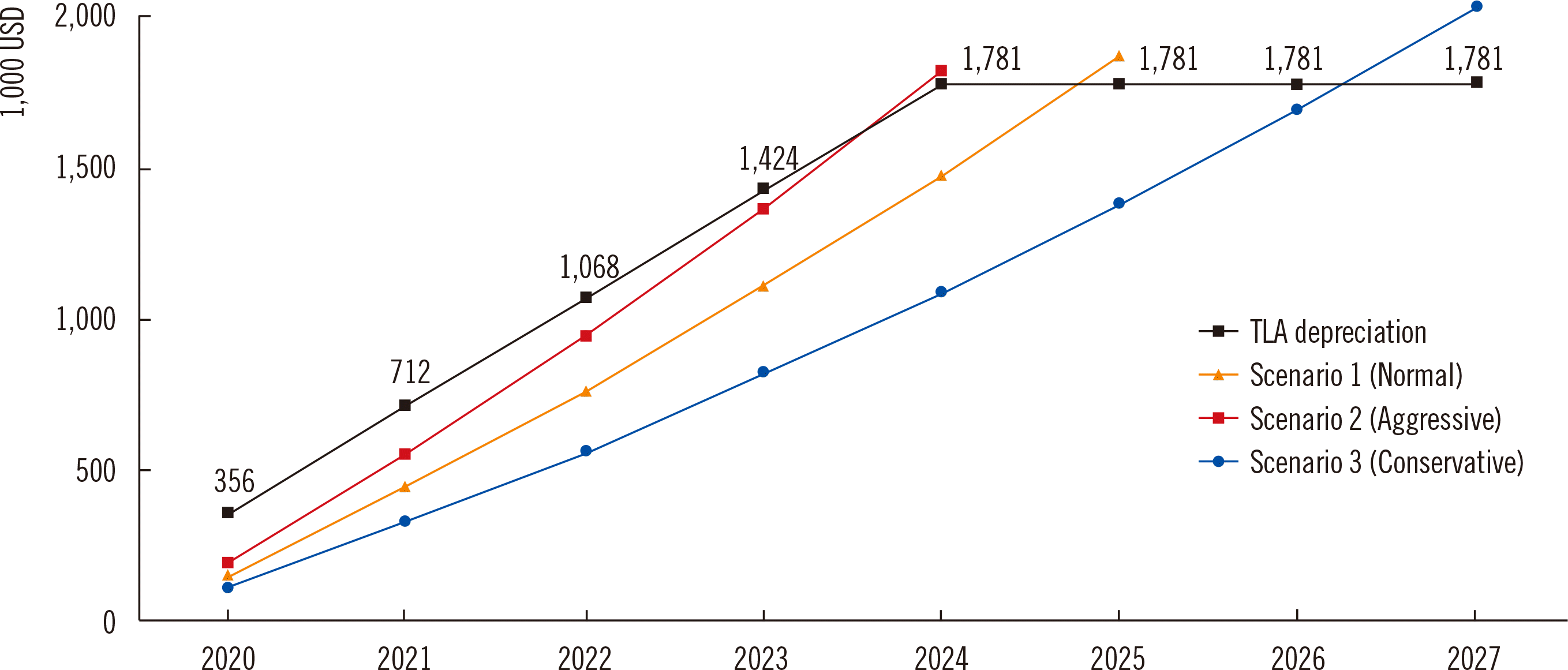1. Melanson SEF, Lindeman NI, Jarolim P. 2008; How laboratory automation can help laboratories, clinicians, and patients. Lab Med. 39:137–43. DOI:
10.1309/YK4WXG5T1P8UCNG4.

2. Sasaki M, Kageoka T, Ogura K, Kataoka H, Ueta T, Sugihara S. 1998; Total laboratory automation in Japan. Past, present, and the future. Clin Chim Acta. 278:217–27. DOI:
10.1016/S0009-8981(98)00148-X. PMID:
10023829.
5. Lippi G, Da Rin G. 2019; Advantages and limitations of total laboratory automation: a personal overview. Clin Chem Lab Med. 57:802–11. DOI:
10.1515/cclm-2018-1323. PMID:
30710480.

6. Hawker CD, Roberts WL, Garr SB, Hamilton LT, Penrose JR, Ashwood ER, et al. 2002; Automated transport and sorting system in a large reference laboratory: part 2. Implementation of the system and performance measures over three years. Clin Chem. 48:1761–7. DOI:
10.1093/clinchem/48.10.1761. PMID:
12324493.

7. Archetti C, Montanelli A, Finazzi D, Caimi L, Garrafa E. 2017; Clinical laboratory automation: a case study. J Public Health Res. 6:881. DOI:
10.4081/jphr.2017.881. PMID:
28660178. PMCID:
PMC5477477.

8. Ellison TL, Alharbi M, Alkaf M, Elimam S, Alfaries M, Al Nounou RA, et al. 2018; Implementation of total laboratory automation at a tertiary care hospital in Saudi Arabia: effect on turnaround time and cost efficiency. Ann Saudi Med. 38:352–7. DOI:
10.5144/0256-4947.2018.352. PMID:
30284990. PMCID:
PMC6180219.

9. Sarkozi L, Simson E, Ramanathan L. 2003; The effects of total laboratory automation on the management of a clinical chemistry laboratory. Retrospective analysis of 36 years. Clin Chim Acta. 329:89–94. DOI:
10.1016/S0009-8981(03)00020-2. PMID:
12589970.

10. Hawkins RC. 2007; Laboratory turnaround time. Clin Biochem Rev. 28:179–94. PMID:
18392122. PMCID:
PMC2282400.
11. Miler M, Nikolac Gabaj N, Dukic L, Simundic AM. 2017; Key performance indicators to measure improvement after implementation of total laboratory automation Abbott Accelerator a3600. J Med Syst. 42:28. DOI:
10.1007/s10916-017-0878-1. PMID:
29280007.

12. Holland LL, Smith LL, Blick KE. 2005; Reducing laboratory turnaround time outliers can reduce emergency department patient length of stay: an 11-hospital study. Am J Clin Pathol. 124:672–4. DOI:
10.1309/E9QPVQ6G2FBVMJ3B. PMID:
16203280.
13. Drummond MF, Sculpher MJ, Claxton K, Stoddart GL, Torrance GW, editors. 2015. Methods for the economic evaluation of health care programmes. 4th ed. Oxford University Press;Oxford: p. 4.
14. Cleemput I, Neyt M, Thiry N, De Laet C, Leys M. 2008; Threshold values for cost-effectiveness in health care Health Technology Assessment (HTA). KCE Rep. 100C (D/2008/10.273/96).
16. Yu HE, Lanzoni H, Steffen T, Derr W, Cannon K, Contreras J, et al. 2019; Improving laboratory processes with total laboratory automation. Lab Med. 50:96–102. DOI:
10.1093/labmed/lmy031. PMID:
29982789.

17. Genzen JR, Burnham CD, Felder RA, Hawker CD, Lippi G, Peck Palmer OM. 2018; Challenges and opportunities in implementing total laboratory automation. Clin Chem. 64:259–64. DOI:
10.1373/clinchem.2017.274068. PMID:
28971983.

21. Sciacovelli L, Lippi G, Sumarac Z, West J, Garcia Del Pino Castro I, Furtado Vieira K, et al. 2017; Quality indicators in laboratory medicine: the status of the progress of IFCC Working Group "Laboratory Errors and Patient Safety" project. Clin Chem Lab Med. 55:348–57. DOI:
10.1515/cclm-2016-0929.

22. Karadağ C, Demirel NN. 2019; Continual improvement of the pre-analytical process in a public health laboratory with quality indicators-based risk management. Clin Chem Lab Med. 57:1530–8. DOI:
10.1515/cclm-2019-0019. PMID:
31050651.

23. Seaberg RS, Stallone RO, Statland BE. 2000; The role of total laboratory automation in a consolidated laboratory network. Clin Chem. 46:751–6. DOI:
10.1093/clinchem/46.5.751. PMID:
10794773.

26. Goswami B, Singh B, Chawla R, Gupta VK, Mallika V. 2010; Turn around time (TAT) as a benchmark of laboratory performance. Indian J Clin Biochem. 25:376–9. DOI:
10.1007/s12291-010-0056-4. PMID:
21966108. PMCID:
PMC2994570.

27. Kelley L. 2011; Improving satisfaction performance through faster turnaround times. Radiol Manage. 33:38–41. PMID:
22043733.
28. Howanitz JH, Howanitz PJ. 2001; Laboratory results. Timeliness as a quality attribute and strategy. Am J Clin Pathol. 116:311–5. DOI:
10.1309/H0DY-6VTW-NB36-U3L6. PMID:
11554156.




 PDF
PDF Citation
Citation Print
Print




 XML Download
XML Download